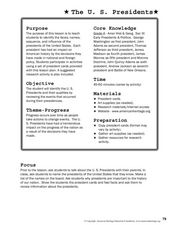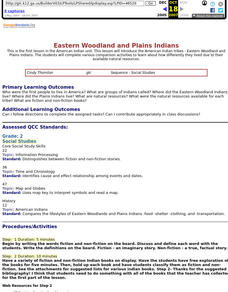Curated OER
Genome Interactions
In this genome interactions worksheet, students read the passage about genome interactions then apply the knowledge to answer several short answer questions.
Curated OER
The U.S. Presidents
Students identify the Presidents of the U.S. by their physical characteristics and their impact on America. In this Presidents lesson plan, students read about each President, look at their pictures, and identify each of them based on...
Curated OER
Changes in Latitudes, Changes in Attitudes
Sixth graders discuss how people, society, and technology change over time through a unit of integrated lessons. In these changes in society lessons, 6th graders discuss the answers to many questions about how changes effect the...
Curated OER
How Many Apple Seeds?
Students complete activities for an apple themed lesson plan. In this math and language arts lesson plan, students read an apple book and guess how many seeds are in an apple. Students draw pictures of apples and use a bobby pin to take...
Curated OER
Valerie Bloom Poetry
Learners listen to Granny Is, a poem by Valerie Bloom and discuss the metaphors in the poem. In this poetry lesson, students read poetry written by Valerie Bloom and discuss the techniques she uses. Learners write grandmother poems.
Curated OER
Eastern Woodland and Plains Indians
Second graders are introduced to the American Indian tribes - Eastern Woodland and Plains Indians. They complete various comparison activities to explore how differently they lived.
Curated OER
Discovery of America
Students examine the European conquest of North America. They participate in activities which allow them to discover the indigenous peoples of the region. They also place events in chrongological order.
Curated OER
Take the Last Train to Clarksville: Arkansas's Historic Depots and Railroad History
Students study the history of railroads and depots in Arkansas using websites and memoirs. They complete activities that explain how and why the railroads were built, and the different ways people used them.
Curated OER
Genre Study
Third graders develop an understanding of genre by participating in small- and whole-group activities. In addition, they practice presentation and specific listening skills. This lesson plan assumes students have been regularly exposed...
Curated OER
Chocolate Chaos
Second graders demonstrate the ability to understand the elements of a story (theme, plot, setting, mood) and characters, by discussing and writing about each. The children have fun with chocolate related activities and enjoy reading...
Curated OER
Land Ho! Early Exploration and Settlement of the Americas
Students complete a unit to learn about early American exploration. In this Americas exploration lesson, students complete eight lessons of activities to learn about Columbus's discovery of the new world and the early exploration of the...
Curated OER
Trickster Tales
Students study folk tales and moral lessons from cultures around the world. In this character traits lesson, students study moral lessons through the character traits in various cultures folk tales. Students complete 11 activities...
Curated OER
Poetry: Developing a Taste
Students identify nouns in poems. In this poems lesson plan, students read poems, discuss them, analyze them, learn the rhythm, and ultimately define nouns that they discover in their poems.
Pennsylvania Department of Education
Variations of The Gingerbread Boy
Students participate in activities base on the story of the The Gingerbread Boy. In this literacy lesson, students listen to the story before retelling a number of times. They use a variety of props during the retellings such as picture,...
Curated OER
Mountain Myths
Students become familiar with Native American myths and legends created to explain volcanic activity. They apply the clustering, writing process and peer-editing techniques to the writing of an original myth about Mount St. Helens
Curated OER
Insects: Bugs, Science, Entomology
In this lesson, insects are explored through reading of children's literature, classifying insects versus non-insects, drawing and painting various insects, and learning how to clap to certain rhythms while reciting insect names.
Curated OER
The Experience of Diary Writing
Students read sections of Mackenzie King's diary. King was the Prime Minister of Canada during WWII. They relate the importance of keeping a diary.
Curated OER
CSAP Preparation: Don't Wait for the "Eleventh Hour"
Fifth graders participate in language arts activities designed to prepare them for taking standardized tests. The language arts format covers science and social studies content. Handouts and worksheets are included in the lesson.
Curated OER
Production Work Sample
Eleventh graders practice reading a basic blueprint for a closet. Using the blueprint, they identify the parts, measure and cut the wood and square a wall. They review safety procedures and use hand tools to attach a track to a cement...
Curated OER
Listen and Do Art
Students listen to directions and complete an art project. They distinguish among kinds of information and purposes and complete multi-step tasks. The teacher gives directions while the student learns, and subsequently the student has to...
Curated OER
Homesick
Students are read the books "Tanya's Reunion' and "Christina Katrina". As a class, they recall events of the stories in the correct sequence. They discuss the traditions they have within their own families and are introduced to the...
Curated OER
Graphing Coordinates
Sixth graders practice graphing coordinates. In this geometry lesson plan, they use the x and y axis to locate points that must be connected in the right sequence to form a straight line.
Curated OER
Birthday Party
Students help plan a party for Q-Bear and think about some of the different ways people celebrate their birthdays. They then demonstrate knowledge and understanding of customs and traditions associated with participation in cultural...
Curated OER
How Many Ice Creams?
Students discuss their favorite ice cream flavors and read the math problem. They brainstorm the problem and brainstorm for ways to solve the problem. Students work in pairs and share solutions.

























